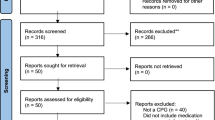Abstract
Despite dissuasive recommendations, intramuscular (i.m.) injections of NSAIDS are still a widespread treatment of acute pain in General Practice as well as among orthopaedic physicians. Most physicians argue that patients who are used to receive NSAIDS i.m. would insist on this application mode while being convinced of its therapeutic superiority for pain relief. Therefore, the aim of the study was to find out if patients’ decision can be influenced towards an oral application by receiving a simple information leaflet. An information leaflet, providing information about the risks of NSAIDS particularly in case of i.m. application was provided to 161 patients with acute low back pain. Decision in favour or against i.m. application of NSAIDS was documented. Severity of disease was assessed by the Roland Morrison pain questionnaire and visual analogue scale (VAS) at the first visit and again 3–5 days later. From May to December 2004, 161 patients, visiting their GP (13 practices) with acute pain and demanding an injection were included in the study. After reading the information leaflet, 139 of the 161 (86.3%) patients decided for an oral application instead of receiving an injection of NSAIDS as in the past. This effect was statistically significant (P≤0.01). Of the initial 161 patients, 156 could be re-evaluated and no significant differences in the VAS and the Roland Morris Score between the patients with oral and i.m. application mode could be found. Only 2 patients of the 139 who decided for oral application indicated that they would opt for an i.m. injection next time. Our study demonstrates that patients’ decision can be influenced even in case of severe pain by providing adequate information on a short information leaflet. The results should help to reduce physicians’ fear of losing patients when not following their demand for i.m. injections and therefore enable a safer pain treatment.
Similar content being viewed by others
References
Arzneimittelkommission der deutschen Ärzteschaft (2003) Kreuzschmerzen - Arzneiverordnung in der Praxis. Deutscher Ärzteverlag, Köln
Becker A, Chenot JF, Niebling W, Kochen MM (2004) Guidelines for back pain. Z Orthop Ihre Grenzgeb 142(6):716–719
Braun RN (1956) Diagnosis in everyday practice. Dtsch Med Wochenschr 81(31):1236–1238
Brune K, Lanz B (1985) Pharmakokinetics of non-steroidal anti-inflammatory drugs. In: Bonta M, Bray MA, Parnham MJ (eds) Handbook of inflammation. Elsevier, Amsterdam, pp 413–449
Caudill-Slosberg MA, Schwartz LM, Woloshin S (2004) Office visits and analgesic prescriptions for musculoskeletal pain in US: 1980 vs. 2000. Pain 109(3):514–519
DEGAM (2004) Leitlinie Kreuzschmerzen. Omnikron publishing, Köln
Deyo RA, Weinstein JN (2001) Low back pain. N Engl J Med 344(5):363–370
Exner V, Keel P (2000) Measuring disability of patients with low-back pain—validation of a German version of the Roland & Morris disability questionnaire. Schmerz 14(6):392–400
Frick S, Cerny A (2001) Necrotizing fasciitis due to Streptococcus pneumoniae after intramuscular injection of nonsteroidal anti-inflammatory drugs: report of 2 cases and review. Clin Infect Dis 33(5):740–744
Gonzalez-Urzelai V, Palacio-Elua L, Lopez-de-Munain J (2003) Routine primary care management of acute low back pain: adherence to clinical guidelines. Eur Spine J 12(6):589–594
Grass H, Schuff A, Bertram C, Rothschild MA (2004) Intramuscular application of diclofenac—case report and critical consideration of a therapeutic measure. Z Orthop Ihre Grenzgeb 142(4):489–492
Hoeffler D, Schwabe U (2002) Letale Fasciitits necroticans nach gleichzeitiger i.m. Injektion von Diclofenac und Dexamethason. Arzneiverordnungen Prax (2):13
Kenny T, Wilson RG, Purves IN et al (1998) A PIL for every ill? Patient information leaflets (PILs): a review of past, present and future use. Fam Pract 15(5):471–479
Koes BW, van Tulder MW, Ostelo R, Kim BA, Waddell G (2001) Clinical guidelines for the management of low back pain in primary care: an international comparison. Spine 26(22):2504–2513
Macfarlane J, Holmes W, Gard P, Thornhill D, Macfarlane R, Hubbard R (2002) Reducing antibiotic use for acute bronchitis in primary care: blinded, randomised controlled trial of patient information leaflet. BMJ 324(7329):91–94
Mayrink M, Mendonca AC, da Costa PR (2003) Soft-tissue sarcoma arising from a tissue necrosis caused by an intramuscular injection of diclofenac. Plast Reconstr Surg 112(7):1970–1971
Pirmohamed M, James S, Meakin S et al (2004) Adverse drug reactions as cause of admission to hospital: prospective analysis of 18 820 patients. BMJ 329(7456):15–19
Roberts L, Little P, Chapman J, Cantrell T, Pickering R, Langridge J (2002) The back home trial: general practitioner-supported leaflets may change back pain behavior. Spine 27(17):1821–1828
Rotman-Pikielny P, Levy Y, Eyal A, Shoenfeld Y (2003) Pyomyositis or “injectiositis”—Staphylococcus aureus multiple abscesses following intramuscular injections. Isr Med Assoc J 5(4):295–296
Schabitz WR, Berger C, Knauth M, Meinck HM, Steiner T (2001) Hypoxic brain damage after intramuscular self-injection of diclofenac for acute back pain. Eur J Anaesthesiol 18(11):763–765
Scheppokat KD (2004) Medical errors and iatrogenic injury—results of 173 Schlichtungsstellen proceedings in general practice. Z Arztl Fortbild Qualitatssich 98(6):509–514
Scheppokat KD (2005) Learning from the experiences as physician member of a German Schlichtungsstelle. Ther Umsch 62(3):185–190
Acknowledgements
The authors wish to thank all the participating doctors and patients. The project is part of PraxArt, financed by the German Ministry of Education and Research (BMBF), grant-number 01GK0301. The study was approved by the Ethical Commission of the University of Heidelberg. Approval Number: 139/2004.
Author information
Authors and Affiliations
Corresponding author
Rights and permissions
About this article
Cite this article
Rosemann, T., Joos, S., Koerner, T. et al. Use of a patient information leaflet to influence patient decisions regarding mode of administration of NSAID medications in case of acute low back pain. Eur Spine J 15, 1737–1741 (2006). https://doi.org/10.1007/s00586-006-0068-1
Received:
Revised:
Accepted:
Published:
Issue Date:
DOI: https://doi.org/10.1007/s00586-006-0068-1




